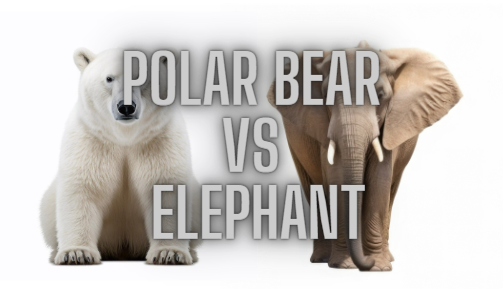Polar bears and elephants are two iconic and awe-inspiring creatures that inhabit vastly different environments. In this article, we will delve into the characteristics, adaptations, and unique attributes of polar bears and elephants, comparing their physical traits, behavioral patterns, ecological roles, and conservation status.
Physical Characteristics
Polar bears are formidable predators of the Arctic, showcasing immense size and strength. Adult males can weigh up to 1,500 pounds (680 kilograms) and stand over 10 feet (3 meters) tall when on their hind legs. They possess a thick layer of insulating blubber, a streamlined body, and powerful limbs. In contrast, elephants are the largest land animals, with African elephants being the largest of their kind. Adult males can weigh up to 12,000 pounds (5,400 kilograms) and reach heights of around 10 to 13 feet (3 to 4 meters) at the shoulder. They are characterized by their long trunks, massive bodies, and distinctive tusks.
Habitat and Adaptations
Polar bears are superbly adapted to the Arctic environment. They have a dense layer of insulating fur and a thick layer of blubber, which keeps them warm in freezing temperatures. Their large, partially webbed paws aid in swimming and walking on ice. Elephants, on the other hand, inhabit diverse habitats such as forests, savannas, and grasslands. They have adapted to these environments with their unique trunk, which serves multiple purposes, including feeding, drinking, communication, and tool usage.
Behavioral Patterns
Polar bears are primarily solitary animals, with the exception of maternal associations and temporary interactions during mating season. They are skilled swimmers and proficient hunters, relying on their patience and powerful swimming abilities to catch seals. Polar bears also exhibit strong maternal instincts, with sows providing care and protection for their cubs.
Elephants are highly social animals, living in complex family structures led by matriarchs. They exhibit intricate communication through vocalizations, body language, and tactile interactions. Elephants are herbivores and spend a significant portion of their day foraging for vegetation. They have a deep sense of familial and social bonds, engaging in cooperative behaviors such as caring for injured individuals and mourning the loss of their kin.
Ecological Roles
Polar bears play a crucial role in the Arctic ecosystem as apex predators. They primarily feed on seals, helping to regulate their populations and maintaining the balance of the food web. Polar bears also scavenge on carcasses and contribute to nutrient cycling in their environment.
Elephants are considered ecosystem engineers, profoundly shaping their habitats. As herbivores, they play a vital role in seed dispersal and vegetation management. Elephants create openings in forests by knocking down trees and branches, which allows sunlight to reach the forest floor and stimulates the growth of various plant species. Their feeding habits contribute to the diversity and composition of plant communities.
Conservation Status and Threats
Both polar bears and elephants face significant conservation challenges. Polar bears are listed as a vulnerable species due to the loss of sea ice habitat caused by climate change. The reduction of sea ice affects their hunting success and overall survival. Elephants, particularly African elephants, are facing threats such as habitat loss, poaching for ivory, and human-elephant conflicts. Conservation efforts focus on protecting their habitats, fighting illegal wildlife trade, and promoting coexistence with local communities.
Who Is Stronger?
Comparing the strength of polar bears and elephants is challenging due to their distinct physical characteristics and adaptations for survival in different environments.
Polar bears are incredibly strong animals, particularly in terms of their size and physical power. Adult male polar bears can weigh up to 1,500 pounds (680 kilograms) and possess powerful muscles and limbs. They use their strength to swim, traverse icy terrain, and hunt their primary prey, seals. Polar bears are known for their ability to deliver strong blows with their forelimbs, an important skill when capturing and subduing their prey.
Elephants, on the other hand, are renowned for their immense size and impressive strength relative to their body mass. African elephants, the largest land animals, can weigh up to 12,000 pounds (5,400 kilograms). They possess powerful trunks, massive bodies, and strong legs. Elephants use their strength for various activities, such as uprooting trees, digging for water, or defending themselves and their social groups.
Who Is Faster?
In terms of speed, elephants and polar bears have different capabilities due to their distinct adaptations and habitats.
Polar bears are not particularly known for their running speed. They are well-adapted for swimming long distances in the Arctic waters rather than running on land. On land, their large size and weight make them more adept at walking or trotting rather than sprinting. While polar bears can achieve speeds of up to 25 miles per hour (40 kilometers per hour) for short bursts, they are not built for sustained high-speed running.
On the other hand, elephants, despite their immense size, are surprisingly agile and capable of impressive speeds. African elephants, in particular, can reach speeds of up to 25 miles per hour (40 kilometers per hour) when moving at a fast pace. However, they cannot maintain this speed for long distances and are more inclined towards a leisurely gait or walking speed.
Final Thoughts
Polar bears and elephants are remarkable creatures, each uniquely adapted for survival in their respective environments. While polar bears are fierce Arctic predators and elephants are gentle giants of the land, both species play vital roles in their ecosystems. It is essential to prioritize conservation efforts to protect these magnificent animals and their habitats, ensuring their continued existence for future generations to marvel at their beauty and appreciate their ecological significance.

